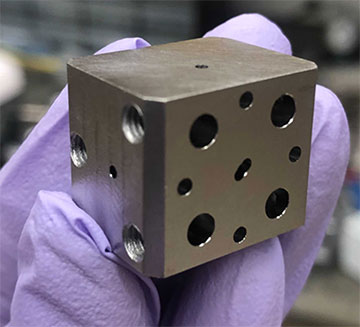
A solid-niobium cube within which a superconducting resonator loaded with laser-cooled rubidium atoms is located at the intersection of three orthogonal waveguides. The atoms convert millimeter-wave photons to optical photons and vice versa. [Image: A. Kumar]
Creating the quantum networks of tomorrow will likely involve converting photons from the microwave frequencies at which many quantum computers operate to the optical frequencies best suited for long-distance communication. But to date, carrying out this conversion efficiently, quickly and also with minimal noise has proven impossible.
Now researchers in the United States reckon they may have cracked the problem, thanks to a novel arrangement of a superconducting resonator and an optical cavity (Nature, doi: 10.1038/s41586-023-05740-2). By loading cold rubidium atoms into the apparatus and exposing them to a carefully coordinated series of laser pulses at different frequencies, the researchers could convert photons at millimeter wavelengths into others at optical wavelengths and vice versa, while preserving the particles’ delicate quantum states.
Efficiently transferring quantum states
A number of the biggest companies looking to commercialize quantum computing, including Google and IBM, are exploiting quantum bits made of microwave photons residing in superconducting circuits. But such photons are highly susceptible to room-temperature thermal noise. Chilling the computers to cryogenic temperatures keeps that noise at bay, but it becomes a real problem if information needs to be sent to other room-temperature computers.
The answer is to convert microwave photons to optical photons and back again, given the latter’s resilience to thermal noise. But that is easier said than done when it comes to quantum information. Researchers have shown how to transfer the state of a superconducting qubit to optical photons using a low-noise nanomechanical resonator, but the conversion efficiency was just 0.1%. Others have managed to efficiently read out a qubit’s state by linking an LC resonator to an optical cavity via a silicon nitride membrane, but they were hampered by noise and low bandwidth.
Neutral atoms are ideal intermediaries in principle because they can be used for both ends of the conversion. When in their ground state, they strongly couple to optical photons, and when excited to Rydberg states, they strongly couple to microwave photons. Indeed, scientists have shown how to exploit Rydberg atoms in this way at room temperature. But efficiently transferring the quantum state of a superconducting qubit with little thermal noise calls for more controlled conditions—coupling the atoms to a superconducting resonator at cryogenic temperatures.
A successful transduction
In the latest work, Aishwarya Kumar, Jonathan Simon and colleagues at the University of Chicago have shown how this can be done. They did so by positioning a superconducting millimeter-wave resonator at the intersection of three orthogonal cylindrical waveguides drilled into a cube of solid niobium. One of the waveguides has mirrors mounted at either end to form an optical cavity. The second waveguide is used to load the cold atoms into the resonator, while the third is the conduit for the millimeter photons being converted to optical frequencies.
The researchers loaded about 1,000 laser-cooled rubidium-85 atoms into the resonator and then exposed them to a precise sequence of laser pulses at ultraviolet, blue and near-infrared wavelengths to access both the optical and microwave transitions. To show that they could indeed convert millimeter-wave quantum information to optical frequencies, the researchers compared the optical cavity’s output with and without the millimeter radiation. They found a marked increase of optical photons in the former case, allowing them to rule out straightforward conversion of thermal photons.
Carrying out the experiment many times, Kumar and co-workers were able to make significant progress toward satisfying each of the three basic criteria for a successful transduction of microwave to optical frequencies. They recorded a conversion efficiency of about 60% and a bandwidth of 360 kHz—enough to outpace the decay of a computer’s superconducting qubits, according to Simon. They also measured an added thermal noise of 0.6 photons—thermal noise must be much smaller than 1 photon to preserve the qubits’ quantum states.
Quantum and beyond
The researchers say that applying the scheme to actual quantum computers will involve directly coupling atoms and superconducting qubits by using different atomic states in larger, colder resonators. They also believe there is plenty of room for improvement—pushing the efficiency close to 100% and increasing the bandwidth by using more atoms and higher power in the blue laser while drastically reducing noise by further cooling the millimeter-wave cavity from its current 5 K to 1 K.
Kumar and colleagues add that the work could find applications beyond quantum networks. The transduction scheme could enable detection of individual millimeter-wave photons in, for example, searches for axion dark matter or entanglement-enhanced observation of astrophysical sources. Besides transduction, they add that the research could also aid the development of a novel variety of quantum computer that combines nearest-neighbor gates based on Rydberg interactions and long-range gates relying on superconducting cavities.
